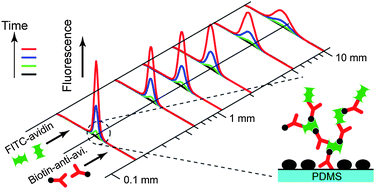Spatial distribution of laminar flow-assisted dendritic amplification†
Abstract
In this paper, we report spatial distribution of laminar flow-assisted dendritic amplification (LFDA) product. LFDA is a recently invented signal amplification method dedicated to biomolecular binding events on microchannel walls. Onto the bound biomolecule, a dendritic structure is constructed by supplying two building blocks from laminar streams produced by a Y-shaped microchannel. In view of the extension of LFDA to simultaneous amplification of multiple binding spots, we have investigated the distribution of the LFDA product across and along the microchannel with the course of time. We fabricated a Y-shaped microchannel with a cross section of 110 µm × 22 µm using poly(dimethylsiloxane). As the LFDA building blocks, FITC-labeled streptavidin and biotinylated anti-streptavidin were injected from the two inlets of the microchannel at a mean flow velocity of 6.2 mm s−1 (after the confluence). Nonspecific


 Please wait while we load your content...
Please wait while we load your content...